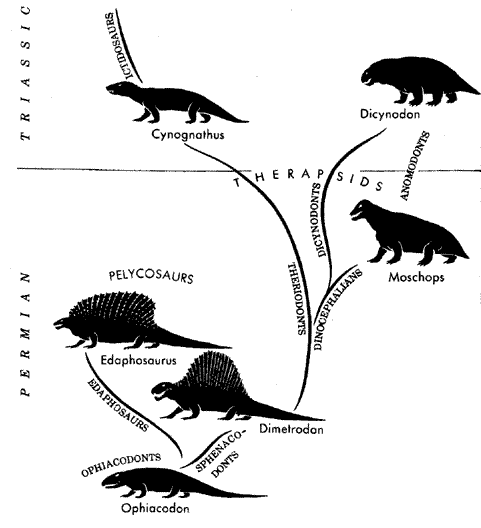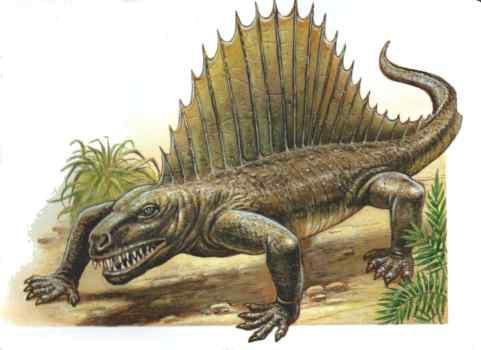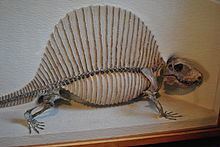Kingdom Animalia Clade Reptiliomorpha Clade Synapsida | Phylum Chordata Clade Amniota Informal group †Pelycosauria | |
 | ||
Representative species Edaphosaurus, Ophiacodon, Edaphosauridae, Sphenacodon, Caseidae | ||
Pl3 mammal evolution pelycosaur skull
The pelycosaurs (from Greek πέλυξ pelyx 'wooden bowl' or 'axe' and σαῦρος sauros 'lizard') are an informal grouping (previously considered an order) composed of basal or primitive Late Paleozoic synapsids, sometimes erroneously referred to as "mammal-like reptiles". They consist of all synapsids except for the therapsids and their descendants. Some species were quite large and could grow up to 3 metres (10 ft) or more, although most species were much smaller. Because more advanced groups of synapsids evolved directly from 'pelycosaurs', the term had fallen out of favor among scientists by the 21st century, and is only used informally, if at all, in the modern scientific literature.
Contents
- Pl3 mammal evolution pelycosaur skull
- Pl3 mammal evolution pelycosaur to mammal transition
- Evolutionary history
- Characteristics
- Classification
- References

Pl3 mammal evolution pelycosaur to mammal transition
Evolutionary history

The pelycosaurs appeared during the Late Carboniferous and reached their acme in the early part of the Permian Period, remaining the dominant land animals for some 40 million years. A few continued into the Capitanian. They were succeeded by the therapsids.
Characteristics

At least two pelycosaur clades independently evolved a tall sail, consisting of elongated vertebral spines: the edaphosaurids and the sphenacodontids. In life, this would have been covered by skin, and likely functioned as a thermoregulatory device or as a mating display. Pelycosaur fossils have been found mainly in Europe and North America, although some small, late-surviving forms are known from Russia and South Africa.

Unlike lepidosaurian reptiles, pelycosaurs lacked epidermal scales. Fossil evidence from some varanopids shows that parts of the skin was covered in rows of osteoderms, presumably overlain by horny scutes. The belly was covered in rectangular scutes, looking like those present in crocodiles. Parts of the skin not covered in scutes could have had naked, glandular skin like that found in some mammals. Dermal scutes are also found in a diverse number of extant mammals with conservative body types, such as in the tails of some rodents, sengis, moonrats, the opossums and other marsupials, and as regular dermal armour with underlying bone in the armadillo.

In 1940, the group was reviewed in detail and every species known at the time described (and many illustrated) in an important monograph by Alfred Sherwood Romer and Llewellyn Price.

Pelycosauria is a paraphyletic taxon because it excludes the therapsids. For that reason, the term is sometimes avoided by proponents of a strict cladistic approach. Eupelycosauria is used to designate the clade that includes most Pelycosaurs, along with the Therapsida and the Mammals. In contrast to "Pelycosaurs", this is a monophyletic group. Caseasauria refers to a pelycosaur side-branch, or clade, that did not leave any descendants.
The pelycosaurs appear to have been a group of synapsids that had direct ancestral links with the mammalia, having differentiated teeth and a developing hard palate.
Well-known pelycosaurs include the genera Dimetrodon, Sphenacodon, Edaphosaurus, and Ophiacodon.
Classification
In traditional classification, the order Pelycosauria is paraphyletic—that is, it is a grouping of animals that does not contain all descendants of a common ancestor, as is often required by a different system of naming organisms, phylogenetic nomenclature. In traditional taxonomy, Therapsida was separated from Pelycosauria in its own biological order, and mammals were separated from both as their own class, though such usage has not been continued by a majority of scientists since the 1990s. In phylogenetic nomenclature, "Pelycosauria" is not used, since it does not constitute a clade (a group of organisms descended from one common ancestor and including all the descendants of that ancestor), as the group excludes the therapsids. Instead, it represents a paraphyletic "grade" of basal synapsids leading up to the clade Therapsida. The following classification was presented by Benton in 2004.
